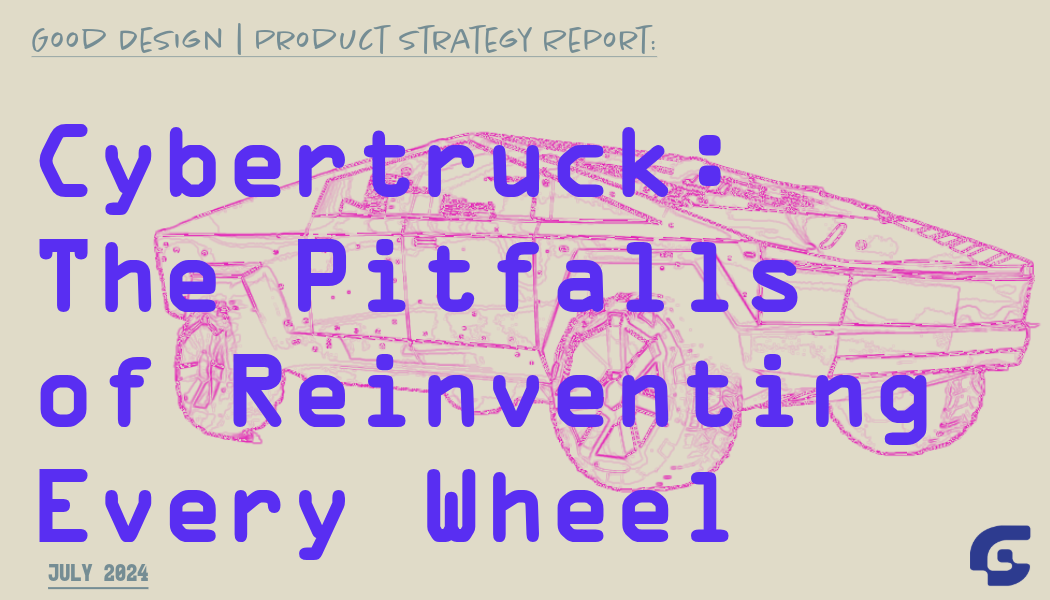How to Spot A Bad Idea: Why RoboTaxi Won't Work
Tam Danier • 2024-04-17
The article critiques the concept of robotaxis, highlighting significant challenges in desirability, viability, feasibility, and usability that hinder its potential success as a transportation solution. It argues that while autonomous vehicles may play a role in future mobility, a fully autonomous taxi system is unlikely to replace personal car ownership due to the complexities involved.
The competition to develop fully autonomous vehicles has intensified recently, with tech giants and automakers investing billions in pursuing a driverless future. One of this technology's most highly anticipated applications is the robotaxi—a fleet of self-driving cars that could potentially replace personal vehicle ownership and revolutionize urban transportation.
Among the many companies claiming to revolutionize the transportation industry, Tesla's plans to introduce a fully autonomous robotaxi have raised some concerns. However, a closer look at the concept through GIO's strategic frameworks reveals some significant issues that doubt its viability. By conducting a Desirability, Viability, Feasibility, Usability (DVFU), and What Must Be True (WMBT) analysis, it becomes clear that the robotaxi faces significant obstacles to adoption and may be fundamentally flawed as a business model.
The State of Autonomous Driving
While the dream of self-driving cars has captured imaginations for years, the reality has proven more challenging. Despite Elon Musk's bullish timelines, Tesla has yet to deliver a vehicle that can drive itself without human supervision. Competitors like Waymo have launched limited robotaxi services but with caveats—the vehicles are constrained to mapped areas and still require human oversight.
Regulatory hurdles also remain. Lawmakers are grappling with how to ensure the safety of autonomous vehicles before unleashing them en masse on public roads. High-profile crashes involving Tesla's Autopilot have only intensified scrutiny.
The Fundamental Hypothesis
The core strategy behind robotaxis is to eliminate the need for personal cars in cities by providing ubiquitous, on-demand autonomous transportation. Companies envision fleets of self-driving electric vehicles constantly roaming the streets, available for hailing via smartphone apps. Passengers would input their destination and be whisked away by the nearest empty robotaxi.
Proponents argue that this model would be cheaper and more convenient than car ownership while reducing traffic, emissions, and parking requirements. By utilizing vehicles more efficiently, robotaxis could, in theory, drive down consumer transportation costs. The vehicles could also provide mobility to those unable to drive themselves.
Applying the DVFU Framework
Let's examine Tesla's robotaxi plan through the lens of GIO's DVFU framework:
Desirability - Do people really want this?
At first glance, a cost-effective and efficient robotaxi service seems desirable for consumers. With no more expenses associated with car ownership, no parking woes, and no need to worry about driving, companies like Amazon and Tesla are optimistic about changing people's attitudes toward personal vehicles. However, the question remains: Do consumers truly want and need a robotaxi network? While the convenience factor is certainly appealing, safety, reliability, and privacy concerns may pause riders. Entrusting your life to a self-driving car with no human backup requires a high degree of trust that has yet to be earned.
Several key desirability factors are missing:
- Lack of privacy and personal space compared to owned vehicles
- Inability to keep personal items in the vehicle
- Concerns around cleanliness and maintenance of shared fleet
- Loss of freedom and spontaneity that comes with car ownership
- For many, the drawbacks of relying solely on robotaxis likely outweigh the benefits. The core value proposition needs to be revised for a large segment of consumers.
Viability - Can this actually work in the real world?
Can robotaxi companies achieve their vision both technically and from a business standpoint? Take Tesla, for example, which has encountered difficulties in scaling production of its existing models and is also facing cash burn. Achieving full autonomy is a highly complicated challenge that demands considerable investment in R&D. It remains to be seen if Tesla has the necessary expertise and financial resources to accomplish this feat.
The economics and operational realities of robotaxi fleets pose significant challenges to viability:
- Scalability constraints: Replacing high-capacity public transit requires an enormous number of robotaxis. Matching peak commuter demand is infeasible.
- Underserved markets: Profit-seeking corporations have little incentive to provide equitable service to low-income areas. Social goals and business objectives clash.
- Vandalism and crime: Expensive, unattended robotaxis are prime targets for theft, damage, and passenger security threats. Restricting service areas defeats the purpose.
- Technological readiness: Despite the hype, no robotaxi has demonstrated the autonomous capabilities needed for safe, reliable, driverless operation in all conditions.
Feasibility - Is this the right approach?
The robotaxis concept has a fundamental flaw. It aims to replace high-capacity public transit with single-occupancy vehicles, a dubious value proposition.
- Widespread use of robotaxis may increase traffic and curb space demands and mobility inequities instead of reducing congestion and improving transportation access.
- Although the technology has improved, completely driverless operation in all conditions remains elusive.
- Edge cases like construction zones, bad weather, and unpredictable human behavior pose significant obstacles.
- Questions around liability when crashes inevitably occur are still unresolved.
Usability: Will people actually use this?
It is still uncertain whether people will trust and widely adopt autonomous taxis.
Several factors may impact the adoption and usability of robotaxis:
- Trust and safety concerns: Many consumers still have reservations about self-driving technology. Demonstrating a near-perfect safety record over millions of real-world miles is necessary to build trust.
- User experience: Robotaxi companies must ensure a seamless, intuitive, and reliable user experience to encourage adoption. This includes easy booking, punctual arrivals, and clean, well-maintained vehicles.
- Privacy concerns: Addressing data privacy issues is crucial, as robotaxis will collect sensitive information about riders' locations and travel patterns. Transparent data handling practices and robust security measures are essential.
- Accessibility: Robotaxis must accommodate diverse needs, including passengers with disabilities, elderly individuals, and families with children. Failure to provide inclusive service could limit usability.
- Integration with existing transportation: Robotaxis should complement, rather than compete with, public transit and other mobility options. Smooth integration and interoperability will enhance usability.
What Must Be True
For robotaxis to succeed, several critical assumptions must hold:
- Full autonomy achievable in the near term at scale
- Cost per mile is low enough to be cheaper than personal car ownership
- Regulatory approval and public acceptance of ubiquitous robotaxis
- Ability to serve diverse transportation needs and edge cases
- Profitable unit economics, even in lower-density areas
- Minimal increases in traffic, congestion, and urban sprawl
- Limited monopolistic behavior and adequate service to underserved areas
- Autonomous driving technology must be advanced enough to operate safely in all conditions without human oversight.
- Municipalities must modify curb access, traffic laws, and parking to accommodate high-volume robotaxi service.
- Robotaxi fleets must be able to scale to meet demand and maintain equitable coverage without public subsidies.
- Measures must be taken to prevent vandalism, crime, and misuse without compromising convenience.
- The technology must work near-flawlessly to gain consumer trust without issues.
- Riders must enthusiastically embrace the service over alternatives like personal vehicles, ride-hailing, and public transit.
The Takeaway:
The concept of a fully autonomous taxi system, or "robotaxis," has been widely discussed as a possible solution to urban mobility challenges. However, this idea is still far from fully realized due to several key prerequisites that must be met before it becomes a reality. Until these conditions are met, the robotaxi concept will remain an overhyped pipedream rather than a true mobility revolution.
According to an analysis by DVFU, these prerequisites seem unlikely to align anytime soon. Therefore, Tesla's decision to shift its focus from an affordable, human-driven electric vehicle to a robotaxi system could be a costly distraction that risks ceding ground to competitors who are bringing compelling options to the market.
While autonomous vehicles will undoubtedly play a role in the future of transportation, an all-robotaxi system that replaces personal car ownership seems highly unlikely. This concept ignores the immense complexity involved in upending transportation as we know it.
A more plausible scenario is that autonomous vehicles will gradually become incorporated into existing transportation systems in limited, geographically constrained applications as the technology matures. They could complement public transit, enhance car-sharing, or serve niche use cases. However, the vision of cities teeming with nothing but robotaxis is a utopian fantasy that ignores the harsh realities of transportation, economics, and human behavior.
In conclusion, while robotaxis may make for great headlines and slick demos, they fall short under strategic scrutiny. It's crucial to rigorously define the concept, verify the assumptions, foresee the implications, and address the key requirements. Doing so clarifies that ubiquitous robotaxis is a well-intentioned but ill-conceived solution to urban mobility. Instead, cities and societies looking to improve transportation should invest in proven solutions like public transit, cycling infrastructure, and prudent regulation. When tech companies pitch robotaxis as a panacea, the correct response is: "I'll believe it when I see it."
The GIO Team
About The Good Design | Center of Excellence Newsletter
For digital leaders aiming to drive growth through human-centric innovation, the Good Design Center of Excellence newsletter offers an inside look at GIO's approach. Through digestible videos and articles, you'll gain strategic insights to bridge the gap between vision and execution.





